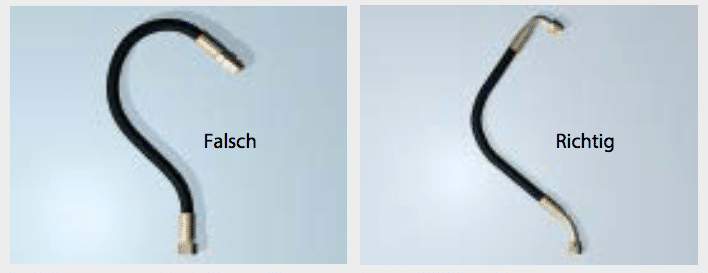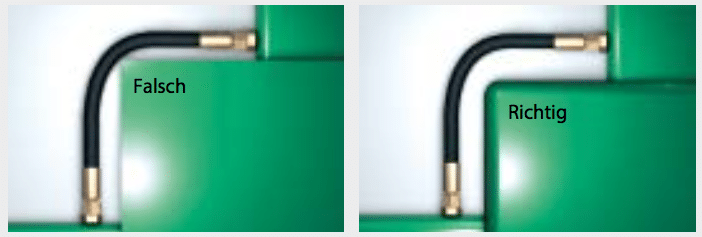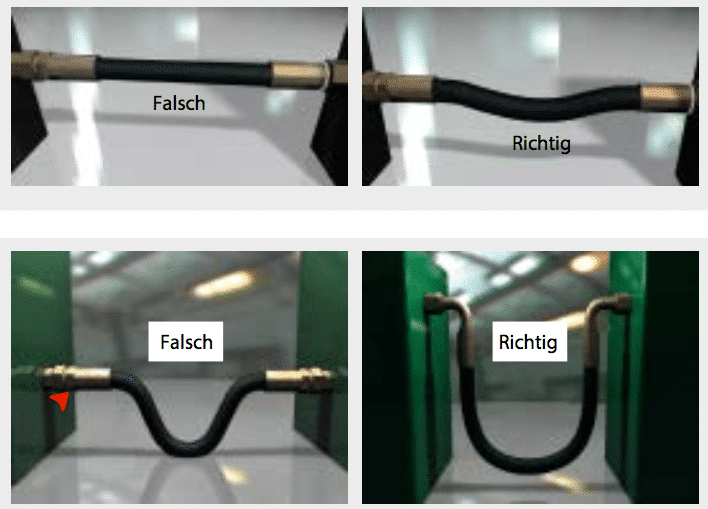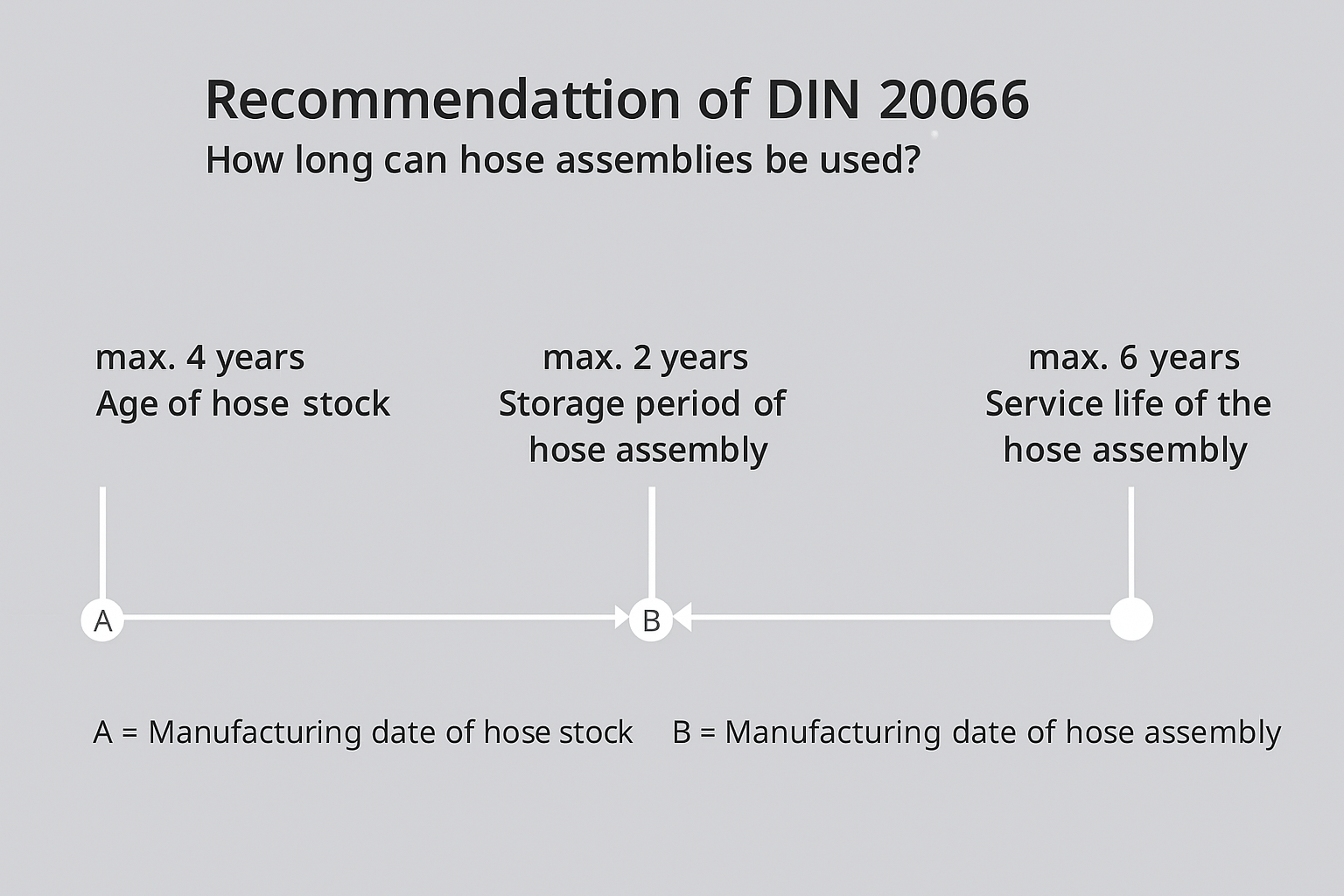
Hose Assemblies
Technical Information
1. Assembly
1.1 Basic Guidelines for Assembling Hose Assemblies
To ensure the functionality of hose assemblies and not shorten their service life through additional stresses, the following requirements must be met:
- Installation of hose assemblies must be carried out by competent personnel
- Hose assemblies must be installed so they are always accessible and their natural position and movement are not impeded
- During operation, hose assemblies must not be subjected to tensile, torsional or compressive forces from external influences
- The minimum bending radius specified by the manufacturer must not be undershot
- Hose assemblies must be protected against mechanical, thermal or chemical damage from external sources
- Before commissioning, check that all detachable connections are secure
- Do not operate a hose assembly if visible external damage is present
- Before commissioning, clean the hose assembly as required
- For hose assemblies requiring equipotential bonding per TRBS 2153 (formerly BGR 132), check and, if necessary, retrofit bonding
- Determine hose length based on installation conditions, accounting for possible shortening or elongation under pressure per supplier data or hose standard
Note: Operating conditions combining maximum pressure, maximum temperature and minimum bending radius will shorten the service life of hose assemblies!
1.2 Additional Information on Assembling Hose Assemblies
Choosing the right hose assembly is crucial for safe and economical operation of a hydraulic system. Criteria include:
- Compatibility with the medium—including cleaning processes
- Temperature resistance—check pressure–temperature behavior
- Specific environmental conditions and external influences
- Pressure resistance including required safety factors (also vacuum behavior)
- Nominal sizes and resulting flow velocities
- Bending radii
- Changes in length and outer diameter
- Special stresses from external forces or pressure impulses
- Abrasion behavior and possible protection
- Availability of hose material and fittings
- Installation conditions such as movement cycles, kinking, whipping, marking, swivel angles of elbows, leg lengths
- Secure sealing forms (seal head design)
- Required approvals
Note: Operating conditions combining maximum pressure, maximum temperature and minimum bending radius will shorten the service life of hose assemblies!
Always verify compatibility of hose and fitting materials with conveyed media. Consider surrounding media in selection.
Consider expected operating and ambient temperatures when selecting a hose assembly. Using hoses outside their permissible temperature range will significantly shorten service life. Valid data can be found in the respective datasheets.
Note that the outer layer of a rubber hose is susceptible to environmental influences like ozone or strong UV radiation. Ozone and UV can break the polymer chains of the elastomer, causing loss of elasticity, hardening and brittleness, leading to radial cracks extending to the reinforcement, especially on outer bends.
Maximum working pressure (dynamic working pressure) determines hose construction and selection. Depending on application, hoses with textile braid, wire braid, spiral wire reinforcement or special metal/PTFE hoses are available.
The inner diameter of hose or pipe is critical in hydraulic systems. Fluid flow incurs pressure loss, depending on flow type, wall roughness, length, inner diameter, fluid density and velocity. Also consider “run-up length” affecting velocity profile. Pressure losses also occur through fittings, valves, bends and other restrictions.
Generally, to minimize losses choose a sufficiently large inner diameter or flow cross-section. When in doubt, select the next larger size to reduce flow velocity and pressure loss.
If a hose assembly is installed with twist, service life is markedly reduced by internal abrasion of the reinforcements. Under impulse pressure, the reinforcement strives to return to its neutral position. Special stress occurs at attachment points.
Note: As a rule of thumb, 7° twist reduces service life by 80%. Ensure no twist occurs during installation, e.g. when tightening the swivel nut.

Each hose type has a specified minimum bend radius by nominal size. Undershooting it reduces service life and load capacity: on the outside bend, gaps in the braid can cause oil seepage; on the inside bend, reinforcement is compressed and loses pressure capacity. This typically occurs immediately behind the fitting when sharply bent.

If installation permits, introduce bends after a straight run equal to 1.5 × outer diameter. If not, use kink guards or similar.

Sometimes, using appropriate fittings can prevent undershooting the minimum radius. As shown above, an angled fitting creates a sufficient bend. Fittings are standard at 45°, 90° and straight; others on request.



Routing over an edge may abrade the outer layer due to hose movement. Likewise, hoses too close together rub each other. The braid then loses corrosion protection, risking failure. If abrasion cannot be avoided, use hoses with high-abrasion outer covers.
Avoid tensile stresses on hose assemblies as they endanger fittings. Note that hoses shorten under pressure (up to 4 % at max pressure), so always install with some slack. Account for movement cycles.
Note: In some cases (e.g. spring‐loaded rollers) tensile stress is unavoidable; permissible loads must then be agreed with HANSA-FLEX.

Avoid clamps that impede natural movement and length changes. Friction in clamping destroys the outer layer over time. Fit clamps only on straight runs.

If hose failure could cause dangerous whipping, restrain or shield the hose. The HANSA-FLEX Stopflex safety system provides a secure connection between hose and machine.
If hose failure could release fluid hazardously, shield the hose accordingly.
Despite cross-linking, rubber can creep between nipple and fitting. This viscoelastic behavior leads to leaks or fitting migration. Peeling the outer rubber layer in the prescribed area minimizes this risk.
When selecting hoses, consider permeation or effusion of gas molecules through the inner layer. Media loss or unwanted concentrations of flammable, explosive or toxic gases may result. Perforating the outer layer (“pricking”) to vent gases is used, e.g. for air lines above 16 bar.
2. Operation
Before commissioning, perform legally required tests (e.g. acceptance, pressure tests) and technical, organizational and personal safety measures. Technical and organizational measures take precedence. If hazards remain, provide and use effective personal protective equipment. The operator must verify suitability of hoses and components for parameters such as temperature, vacuum, pressure and material compatibility. Account for abrasion and plan inspections accordingly.
2.1 Storage of Hose Assemblies
- Store cool, dry and dust-free. Avoid direct sunlight/UV. Shield from nearby heat sources. Prevent contact with damaging substances
- Store hoses and assemblies unstrained, kink-free and lying flat. No rings smaller than the manufacturer’s minimum bend radius
- Cap hose ends to protect from contamination, ozone and corrosion
- Recommended maximum storage: 4 years for hose stock, 2 years for hose assemblies
- Protect metal and PTFE hose assemblies from chlorides, bromides, iodides and rust
2.1.1 General
Under poor storage or handling, rubber products change properties, shortening service life. Changes can be caused by oxygen, ozone, heat, light, moisture, solvents or tension. Properly stored products remain stable for years; unvulcanized rubber compounds are an exception.
2.1.2 Storage Area
Storage must be cool, dry, dust-free and ventilated. Outdoor storage under cover is not permitted. Do not store solvents, fuels, lubricants, chemicals, acids, disinfectants, etc. in the storage area.
2.1.3 Temperature
Storage temperature depends on product and elastomer type. Rubber goods should be stored between –10 °C and +15 °C; by agreement up to +25 °C short-term only. Certain rubbers (e.g. CR) must not be stored below +12 °C.
2.1.4 Heating
In heated rooms, shield rubber products from heat sources by at least 1 m; more if forced air heating.
2.1.5 Humidity
Avoid damp storage. Prevent condensation. Ideal RH < 65 %.
2.1.6 Lighting
Protect rubber from light—especially direct sun and strong UV. Paint windows red or orange (never blue). Prefer incandescent lamps.
2.1.7 Oxygen and Ozone
Protect rubber goods from drafts, airtight containers and other means that trap air, especially high surface-to-volume items (rubber-coated fabrics, cellular products). No ozone-generating equipment (motors, devices that spark) in storage. Eliminate combustion gases/vapours that form ozone photochemically.
3. Maintenance
3.1 Inspection Intervals for Hose Assemblies

3.2 Inspection Criteria for Hose Assemblies

3.3 Repair and Recoating of Hose Assemblies
Repair of hose assemblies using the original hose and/or fitting in the swage area is not permitted. Recoating hose assemblies violates marking requirements.
3.4 Additional Information on Maintenance of Hose Assemblies
3.4.1 Cleaning
Clean rubber products with soap or warm water; dry at room temperature. After long storage (6–8 months), use 1.5 % sodium bicarbonate solution, then rinse with water. Use manufacturer-recommended mild cleaners. Do not use solvents (trichloroethylene, carbon tetrachloride, hydrocarbons), wire brushes or abrasives. Clean rubber–metal assemblies with glycerin–alcohol mix (1:10). If disinfection is needed, do so only after thorough cleaning; disinfectants must be compatible with rubber. Avoid oxygen- or halogen-releasing agents (e.g. potassium permanganate, bleaching powder) on thin-walled products. For medical rubber goods, use only manufacturer-approved disinfectants. A special coating (wax emulsion, shellac) can extend life, except on medical products. Silicon-free requirements need special clean-and-store processes.
3.4.2 Service Life
Current DIN 20066 specifies:
Even with proper storage and use, rubber hoses age and have limited life. Improper storage, mechanical damage and overload are the main failure causes. Service life may be set case-by-case from these guidelines:
- Hose stock used for assembly should be ≤ 4 years old
- Service life of a hose assembly (including storage) should not exceed 6 years
- Storage of an assembled hose should not exceed 2 years
The following graphic illustrates this:

In practice, hydraulic hoses are stored FIFO (first in, first out) so the oldest is used first.
For more on storage and service life see:
- DIN EN ISO 4413, § 5.4.6.5.1 – Hose Assemblies (General Requirements)
- DIN 20066, § 14.1.2 – Storage and Service Life (Recommendation)








































